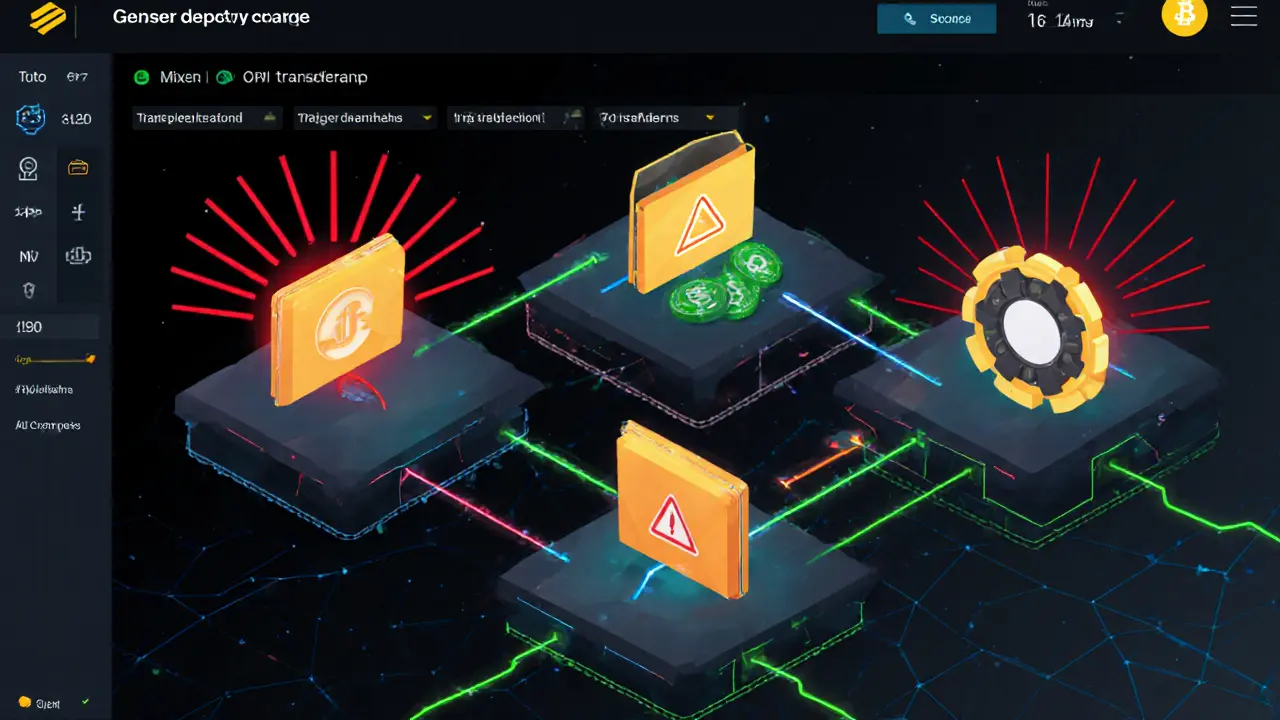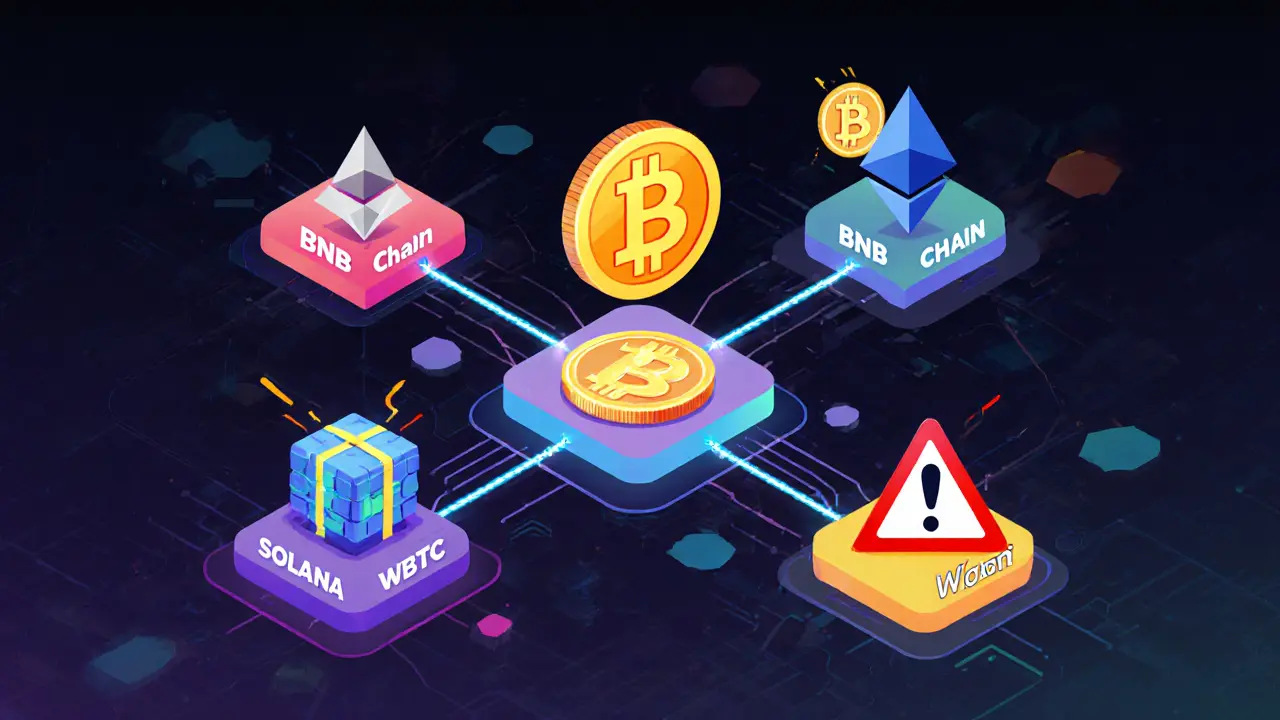Cross-Chain Transaction Risk Assessment Tool
Calculate Your Transaction Risk Score
Enter details about your cross-chain transaction to see how likely it is to be flagged as suspicious by monitoring systems.
Risk Assessment Results
Why this transaction might be flagged
Your transaction shows no patterns typically associated with suspicious activity.
When you send Bitcoin to Ethereum, it doesn’t just disappear and reappear. There’s a trail - a complex, multi-step journey across different ledgers that most people never see. That’s where cross-chain crypto transaction monitoring comes in. It’s not about watching one blockchain. It’s about following money as it jumps from Bitcoin to Ethereum, then to Binance Smart Chain, then to a privacy protocol, and back again. If you’re running a crypto exchange, a DeFi platform, or even managing institutional funds, not knowing where your assets are going is a massive risk.
Why Cross-Chain Monitoring Matters Now
In 2021, over $8.6 billion in cryptocurrency was laundered. A lot of that moved across chains. Criminals don’t stay on one network. They use bridges, wrapped tokens, and atomic swaps to hide their tracks. A wallet that looks clean on Ethereum might be linked to a darknet market on Bitcoin. Without tools that connect the dots between chains, you’re blind. Regulators aren’t waiting. The Financial Action Task Force (FATF), the EU’s AMLA, and the U.S. FinCEN all require crypto businesses to monitor transactions - including those that cross blockchains. If you can’t prove you’re tracking fund flows across networks, you risk fines, license revocation, or being shut down entirely.How Cross-Chain Transactions Actually Work
Cross-chain moves aren’t simple transfers. They use three main methods:- Wrapped tokens - Like WBTC, where Bitcoin is locked and an equivalent token is issued on Ethereum. Every WBTC minted or burned must be tracked back to the original BTC address.
- Atomic swaps - Direct peer-to-peer exchanges between chains without intermediaries. These happen in seconds and leave no central record.
- Bridge protocols - Third-party platforms (like Multichain, Synapse, or Across) that lock assets on one chain and release them on another. Many of these have been exploited, with over $2 billion stolen in bridge hacks since 2020.
The Technology Behind the Monitoring
Cross-chain monitoring systems don’t just read one blockchain. They connect to dozens - Bitcoin, Ethereum, BNB Chain, Solana, Polygon, Litecoin - simultaneously. Each node feeds real-time data: transaction IDs, timestamps, input/output addresses, amounts, and contract interactions. The system then does three things:- Aggregates data - Pulls every transaction from every chain into a single database.
- Links addresses - Uses clustering algorithms to group wallets that likely belong to the same entity. If Wallet A sends BTC to a bridge and Wallet B receives WBTC on Ethereum, they’re linked.
- Flags anomalies - Looks for patterns: sudden large transfers, rapid movement between chains, transactions tied to known mixers or darknet addresses.

What Gets Flagged as Suspicious?
Not every cross-chain move is illegal. But certain behaviors are almost always tied to laundering:- Chain-hopping - Moving funds between 3+ chains in under an hour.
- Fragmentation - Splitting a large sum into dozens of small transfers across multiple wallets and chains.
- Bridge-to-mixer - Sending funds through a bridge, then immediately to a mixer like Tornado Cash.
- Stablecoin jumps - Converting USDT from Ethereum to BNB Chain, then to Solana, then back to Ethereum as USDC.
- Zero-activity wallets - Wallets that sit empty for months, then suddenly receive funds from a bridge and send them out within minutes.
Real-World Use Cases
Crypto exchanges use this daily. When a user deposits BTC, the system checks if that BTC was ever sent to a known mixer. If it was, the deposit gets blocked. If it went through a bridge to Ethereum and then to a DeFi protocol flagged for sanctions violations, the exchange is legally required to freeze it. Payment processors like BitPay and CoinGate use cross-chain monitoring to onboard merchants. They don’t want their clients accepting funds from ransomware gangs. If a merchant’s wallet receives USDT from a wallet that sent funds through a bridge linked to a North Korean hacking group, the merchant gets flagged - before they even cash out. Even institutional investors use it. Hedge funds managing crypto portfolios need to prove they’re not holding tainted assets. If their portfolio includes ETH that was once WBTC tied to a sanctioned address, they could be violating OFAC rules. Monitoring tools let them clean their holdings before investing.The Biggest Challenges
It’s not easy. Here’s what makes cross-chain monitoring hard:- Pseudonymity - Wallets aren’t tied to names. You see addresses, not people.
- Speed - Some atomic swaps complete in 90 seconds. Monitoring systems must react in real time.
- Fragmentation - New bridges pop up weekly. Many aren’t documented. Some are scams.
- Privacy coins - Monero, Zcash, and privacy-focused DeFi protocols obscure transaction details entirely.
- Regulatory gaps - Not all countries require cross-chain monitoring. This creates loopholes.

What to Look for in a Monitoring Tool
If you’re choosing a platform, ask these questions:- Does it cover all major chains? Bitcoin, Ethereum, BNB Chain, Solana, Polygon, TRON, Avalanche - if it doesn’t support them all, you’re missing risks.
- Can it trace wrapped tokens? WBTC, renBTC, wETH - these are the most common laundering tools.
- Does it link addresses across chains? The tool should show you: ‘This BTC address sent to Bridge X, which minted WBTC on Ethereum, which was then sent to Wallet Y.’
- Does it update in real time? Delayed alerts are useless. If a transaction happens at 2:03 PM, you need to know by 2:04 PM.
- Can it integrate with your compliance workflow? Can it auto-generate reports for regulators? Can it block transactions before they complete?
The Future: AI, Regulation, and Mandatory Adoption
Cross-chain monitoring won’t stay optional. By 2026, it’s expected to be mandatory for all VASPs in the EU, U.S., UK, and Singapore. The EU’s MiCA regulation already requires real-time transaction monitoring across chains. AI will get smarter. Instead of just flagging patterns, systems will predict intent. If a wallet sends small amounts to 15 different bridges over 48 hours, the AI won’t just say ‘suspicious.’ It’ll say: ‘92% probability this is layering for laundering.’ And as DeFi grows, so will the need. When you can swap BTC for SOL in one click using a decentralized bridge, the risk skyrockets. Monitoring tools will need to track not just the swap, but the liquidity pools, the smart contracts, and the governance tokens involved.Bottom Line
Cross-chain crypto transaction monitoring isn’t a luxury. It’s the baseline for operating legally in crypto today. If you’re ignoring it, you’re not just ignoring risk - you’re ignoring reality. The money moves across chains. If you’re not tracking it, you’re not in control.What is cross-chain crypto transaction monitoring?
Cross-chain crypto transaction monitoring is the process of tracking cryptocurrency movements between different blockchain networks - like Bitcoin, Ethereum, and BNB Chain - using specialized tools that connect to multiple ledgers. It helps identify suspicious activity, such as money laundering, by linking transactions that span multiple chains, even when assets are wrapped, swapped, or bridged.
Why can’t regular blockchain tools monitor cross-chain transactions?
Regular tools only watch one blockchain at a time. If Bitcoin is converted to WBTC on Ethereum, a Bitcoin-only tool won’t see the Ethereum side. Cross-chain tools connect to multiple chains simultaneously and use algorithms to match transactions across networks - like finding the same person using two different names in two different cities.
Are cross-chain transactions illegal?
No, cross-chain transactions themselves are not illegal. People use them daily to move assets between networks for better fees, faster speeds, or access to DeFi apps. But criminals use them to hide money. The problem isn’t the transfer - it’s the intent. Monitoring tools look for patterns that suggest laundering, not the transfers themselves.
Which cryptocurrencies are most commonly used in cross-chain laundering?
Bitcoin and Ethereum are the most common starting points because they’re widely accepted and have the most bridges. Wrapped Bitcoin (WBTC) is the top tool for laundering - it lets BTC move onto Ethereum, where it’s easier to mix or send to DeFi protocols. Stablecoins like USDT and USDC are also heavily used because they’re pegged to the dollar and widely trusted.
How do regulators enforce cross-chain monitoring?
Regulators like FinCEN and the EU’s AMLA require crypto businesses to monitor cross-chain flows as part of AML compliance. Firms must screen wallets, flag suspicious activity, and report it. Failure can lead to fines up to millions of dollars, loss of licenses, or criminal charges. The Travel Rule also requires sharing sender/receiver info across borders - even for cross-chain transfers.
Can I monitor cross-chain transactions myself?
You can try using free blockchain explorers like Etherscan or Blockchain.com, but they only show one chain. To track cross-chain flows, you need specialized software that connects to multiple blockchains, links addresses across networks, and flags anomalies. These tools are expensive and designed for businesses, not individuals. Most retail users don’t need this - but if you’re running a crypto service, you can’t afford to skip it.
What happens if I ignore cross-chain monitoring?
If you’re a business, you risk fines, legal action, or being blocked from banking partners. Banks won’t work with crypto firms that can’t prove they’re monitoring cross-chain risks. If you’re an investor, you might unknowingly hold tainted assets - which could freeze your funds or trigger regulatory scrutiny. In 2024, over 12 crypto firms were shut down for failing to monitor cross-chain transactions.

Kaela Coren
November 2, 2025 AT 06:45While the technical depth here is commendable, I find myself questioning the scalability of real-time cross-chain aggregation across 15+ blockchains. The computational overhead alone would require enterprise-grade infrastructure, which most mid-sized exchanges simply cannot justify. The latency in address clustering algorithms, particularly with privacy-enhanced transactions, introduces non-trivial compliance blind spots. This isn't a solved problem-it's a moving target.
Nabil ben Salah Nasri
November 2, 2025 AT 09:37This is SO needed!! 🙌 I work in compliance and every week it’s like playing whack-a-mole with bridges that pop up overnight. WBTC is the OG laundering vehicle, but now they’re using wstETH and renBTC like it’s nothing 😅 The tools are getting better, but the bad guys are faster. We need mandatory KYC on all bridges-like, yesterday. 🚨
alvin Bachtiar
November 2, 2025 AT 16:14Let’s be brutally honest: this isn’t monitoring-it’s theater. You think Scorechain can trace a Zcash-to-Monero atomic swap through a decentralized liquidity pool on a rogue bridge built by a Telegram group in Manila? Please. The entire industry is running on 2020-era heuristics while criminals are deploying AI-driven obfuscation. The $2B in bridge hacks? That’s the tip of the iceberg. And no, your ‘risk score’ doesn’t mean anything if it’s based on cluster heuristics that misidentify 30% of legitimate DeFi users as launderers. You’re not catching criminals-you’re punishing degens.
Bhavna Suri
November 3, 2025 AT 00:51This is too long. I did not read all. But I think it is important for banks. Not for me. I just buy and sell. Why so many words?
Eli PINEDA
November 4, 2025 AT 18:34wait so if i send btc to binance and they convert it to wbtc and i send it to uniswap… does that trip a flag?? i just wanted to earn yield 😅
Debby Ananda
November 4, 2025 AT 23:15How quaint. I suppose if you're still using 'wallets' and 'bridges' as if they're physical objects, you're already behind the curve. The future isn't about tracking addresses-it's about tracing intent through semantic graph analysis. If your tool can't infer behavioral entropy across DeFi protocols and correlate it with on-chain governance participation, you're not monitoring-you're doodling with a crayon. 🖋️✨
Vicki Fletcher
November 6, 2025 AT 04:36i think the part about zero-activity wallets is so true… like, why would someone just sit on a wallet for 6 months and then send $200k out in 3 minutes? that’s not investing, that’s a bot or a scam. but also… why do we even have to monitor this? shouldn’t crypto be free? 🤔
Nadiya Edwards
November 7, 2025 AT 18:02They say 'cross-chain monitoring' but what they really mean is 'government surveillance under a fancy name.' You want to track every move? Fine. But don't pretend it's about safety-it's about control. The same people who told us 'crypto is freedom' are now building the most invasive financial surveillance system in human history. And you're applauding it? Wake up. This isn't compliance. It's the end of financial privacy. 🇺🇸
ISAH Isah
November 7, 2025 AT 23:41mark Hayes
November 9, 2025 AT 10:41Really appreciate this breakdown. I’ve seen so many small DeFi projects get shut down because they didn’t have the budget for fancy tools but still got fined for ‘unmonitored flows.’ Maybe the real solution is open-source monitoring nodes that anyone can run? Like a community-run blockchain watchdog. Not perfect, but better than nothing. And hey, if you’re just swapping for yield and not laundering, you’ve got nothing to hide 😊